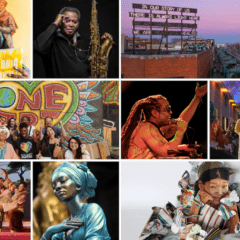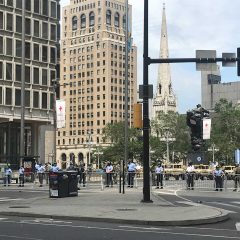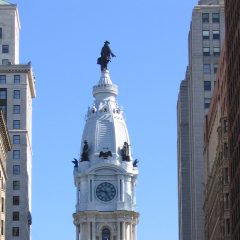As people pass 1515 6th Street in South Philadelphia, on the exterior wall of the building they will see drawings of two large empty circles embraced by falling leaves and rhythmic swirls. Inside the two circles is mostly white space — primed wall — ready to be filled with painted panels that touch on issues of immigration.
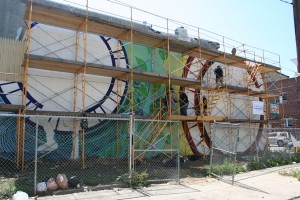
“Aquí y Allá” (“Here and There”), which chronicles stories of immigration told by teens in Mexico and in Philadelphia, was organized by mural artist and Philadelphia native Michelle Ortiz (who has worked with the city’s Mural Arts Program). For over a year and a half, Ortiz worked to gain support and funding from a variety of sources — Philadelphia Academics, Inc., the Mural Arts Education Program, the U.S. Consulate in Juarez, the National Association of Latino Arts and Cultures, the Leeway Foundation, Hispanics in Philanthropy, and individual donations. “It started off as a small idea and it became a reality,” Ortiz explained during an interview at the worksite. She stressed the sustainability aspect of the project for the Philadelphia and Mexico communities. “You have to ask, ‘How can you bring it beyond the wall.’ ”
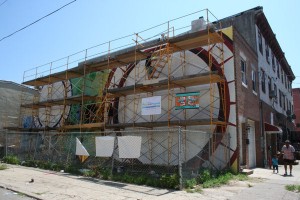
The catalyst for the mural was a 2009-2010 artist residency Ortiz had in Juarez and Chihuahua City, Mexico, in which she painted murals in the two towns and gave mural workshops to local artists. While there, she met artists David “Mambo” Flores and Juan Carlos “Waka Waffles” Reyes of Colectivo Rezizte and Oscar Gallegos and Antonio Leal of Colectivo Madroño, who she brought to Philadelphia to collaborate on “Aqui y Alla”.

In Philadelphia, Flores, Reyes, Gallegos and Leal helped with the design and collaborated on the painting (they are now back in Mexico). Also collaborating are teens in Juarez and Chihuahua, who are students of the Mexican artists, and local teens from Furness High School, who worked with Ortiz during an 8-week summer program sponsored by the Mural Arts Program. The teens are creating the panels that will go into the two large circles.
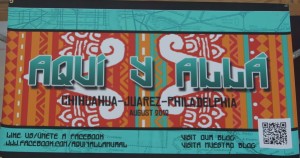
Ortiz developed the curriculum for the 8-week summer program with artist Patricia Barrera, to expose the students to new artistic techniques, while also engaging them in journal writing and communal discussions, and creating a safe space in which to share thoughts, fears, and sufferings. The teens, from Mexican, Puerto Rican, and African-American households, studied artists such as Elizabeth Catlett and Graciela Iturbide, and examined political posters from the Civil Rights and Puerto Rican Independence Movements. Ortiz said, “I wanted to show the kids how it is that these works of art were able to compel the community.”
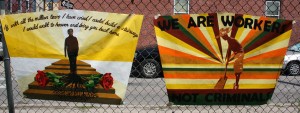
Questions such as “Who am I?”, “Where do I come from?”, and “What do I want to say?” are raised and answered in the mural by Philadelphia students like Fredy, an 18 year old who crossed the U.S.-Mexican border at 10, leaving behind his beloved grandmother who had raised him up til then, to join his mother in Philadelphia. (His mother, who lives in Philadelphia, traveled back to Mexico to take him across the border.) Fredy created two panels. One reads, “We are workers, not criminals,” inspired by the prejudice he experienced after he began working as a young teen. The second is dedicated to his now deceased grandmother, her portrait painted in the center with roots spreading out from her feet.
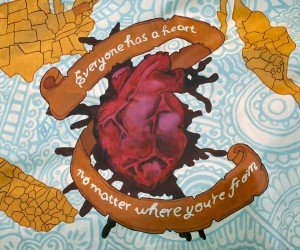
Careana, a student originally from Puerto Rico, created a panel that deals with transition, citizenship, and American history. A heart lies in the center as veins form the outlines of the United States, Puerto Rico, and Mexico – Pennsylvania highlighted as the point of encounter.

Diana, 17, came to Philadelphia from Mexico seven years ago. Her stunning panel is a narrative of the difficulties of immigration. The bird in the cage represents how she felt coming to Philadelphia. “It is so different here than Mexico. Being here, from school to the house, everyday, the same thing. I’m not really happy living here, but I’m accustomed already.”
Full of symbols, the panel represents the teen’s hard times living here – not knowing the language and culture. “I was the first Latina girl in my class.” It also depicts a family tragedy –her father (portrayed on the right) was deported two years ago. “I want people to know how they are separating families without caring.”
While the Philadelphia teens’ panels are finished, the Mexican teens’ panels are still in progress. About his students’ panels, Oscar Gallegos said, “The differences are in the colors and tonalities, but the themes are the same. The problem of immigration is the same, so you see a lot of images of arrows, birds, and walls. The youth are the same youth except that the ones in Mexico stayed. They are mirror images.”
Hopes for “Aqui y Alla” to speak to the South Philadelphia neighborhood run high. Gallegos hopes “First, that the people of the community feel that they are represented in the mural – that they see and feel the questions pertaining to their lives. And second that the mural is a vehicle for the community to communicate.” Antonio Leal adds his hope that the mural would help break down barriers, such as racism and prejudice, and change people’s perspectives.
Perspectives are already changing, according to a story told by David Flores. A neighbor, who on first being asked about the mural, said “I hate Mexicans,” is now “our number one fan,” says Flores, adding that one morning a shop owner from the Italian Market came by and brought them breakfast.
Even the wall’s owner, Jerry, a first-generation Italian who could connect with the teens’ tales of immigration and cultural identity, made sure to provide plenty of space, giving the artists a key to his garage.
During the two hours I was at the mural site interviewing the artists, several neighbors pushing grocery carts home from the market stopped to admire the progress. Some waved, others commented. One woman said in broken English how beautiful the mural is.
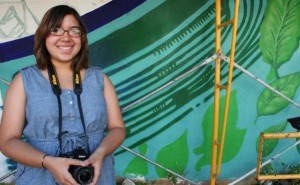
Gabby Loredo, the mural’s videographer, thinks many in the neighborhood will connect with the stories the mural tells. “When I first walked by here it was just a rundown little lot. I want it to be a point of pride for the neighborhood.”
“Aquí y Allá” will be officially dedicated in October 2012 with plans to mount an exhibition of the project, as well as to screen a documentary with the immigrant teen stories.


